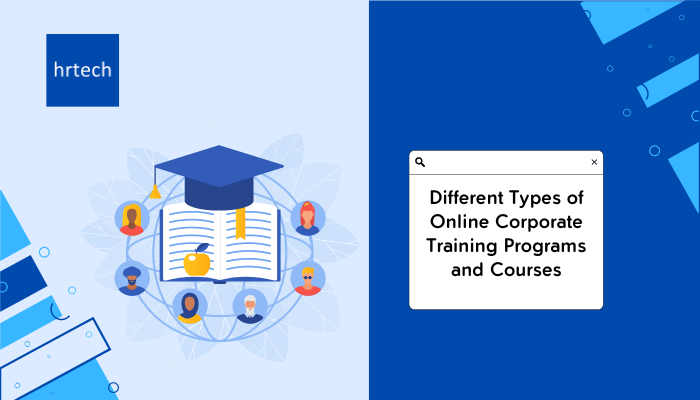Online corporate training programs are the way to go!
They’re flexible.
Cost-effective.
And did you know that companies that invested in employee training are 17% more productive?
From leadership development to effective communication, these programs offer a wide range of benefits. Keep reading to explore the different types of online corporate training programs and find the perfect fit for your organization.
What Are Online Corporate Training Programs?
Online corporate training programs are designed to help employees gain new skills, knowledge, and abilities that support them in excelling in their career and life. The online corporate training programs are typically provided via web-based learning systems.
The main objectives of these programs are to:
Upskill and reskill employees to meet evolving business needs
Improve job performance and productivity
Enhance employee engagement and retention
Topics covered in online corporate training programs typically include:
Leadership and management skills
Communication and collaboration
Project Management
Time Management
And many more…
Online training is delivered through various methods, such as self-paced courses, live webinars, virtual classrooms, and mobile learning apps.
Types of Online Corporate Training Programs:
Leadership Training:
Key Skill Improvement: Effective communication, Decision-making, Team management
Affordability And Ease Of Access: (6/10)
For Whom It’s Best: High-Potential Employees, New Managers

Leadership training is an absolute must-have for any organization that wants to develop strong, effective leaders.
These programs typically cover a wide range of topics, including effective communication, decision-making, team management, conflict resolution, and strategic thinking.
The curriculum often consists of modules that address each of these areas, providing participants with the tools and techniques needed to become successful leaders.
Of course, all this doesn’t come at a lower price. Leadership training programs can range from a few hundred bucks to several thousand per employee, depending on the provider and the scope.
But guess what? It’s totally worth it. According to studies, 1 in every 5 employees that went through a leadership training program, did better in their job.
So, who should you be sending to these leadership training programs? Well, it’s not just for the C-suite. High-potential employees, new managers, and even experienced executives can all benefit from a leadership skills tune-up.
Effective Team Communication Training Essentials:
- Key Skill Improvement: Active listening, Clear and concise messaging, Conflict resolution, Providing constructive feedback, Collaborating in a virtual environment
- Affordability And Ease Of Access: (7/10)
- For Whom It’s Best: Remote or distributed teams, Organizations undergoing significant changes or restructuring
Effective team communication training is a crucial component of online corporate training programs.
The curriculum typically includes modules on active listening, clear and concise messaging, conflict resolution, providing constructive feedback, and collaborating in a virtual environment.
On average, you can expect to invest between $100 to $500 per employee for a comprehensive training program. However, the return on investment (ROI) can be significant, as effective communication leads to increased productivity, reduced misunderstandings, and improved employee morale.
Effective team communication training is particularly beneficial for organizations with remote or distributed teams, as well as those undergoing significant changes or restructuring.
Transforming HR through Agile Workforce Solutions
Project Management Training Objectives:
Key Skill Improvement: Project planning, Risk management, Resource allocation, Stakeholder management, Project monitoring and control
Affordability And Ease Of Access: (6/10)
For Whom It’s Best: Project managers, Team leads, Senior executives overseeing multiple projects
The project management certification courses provide employees the skills and knowledge needed to effectively plan, execute, and deliver projects on time and within budget.
The curriculum typically includes modules on project planning, risk management, resource allocation, stakeholder management, and project monitoring and control.
The cost of project management training can vary depending on the provider and the level of certification offered.
For example, a basic online course may cost around $200 to $500 per employee, while a more comprehensive program leading to a recognized certification, such as the Project Management Professional (PMP), can cost upwards of $2,000 per participant.
Project management training is most beneficial for employees directly involved in project delivery, such as project managers, team leads, and senior executives responsible for overseeing multiple projects.
Insights on the Power of Negotiation:
Key Skill Improvement: Understanding the negotiation process, Preparing for negotiations, Effective communication techniques, Identifying and leveraging bargaining power, Closing deals
Affordability And Ease Of Access: (7/10)
For Whom It’s Best: Sales professionals, Procurement specialists, Senior executives
Online corporate training programs that focus on this area can provide employees with the tools and techniques needed to achieve better outcomes in both internal and external negotiations.
The curriculum for negotiation skills training covers mainly understanding the negotiation process, preparing for negotiations, effective communication techniques, identifying and leveraging bargaining power, and closing deals.
The cost of negotiation skills training can vary widely, depending on the provider and the format of the training.
Online courses can range from $100 to $1,000 per participant, while more intensive programs that include live workshops and role-playing exercises can cost several thousand dollars per employee.
Negotiation skills training is most beneficial for employees who regularly engage in negotiations, such as sales professionals, procurement specialists, and senior executives.
Techniques For Closing The Sale:
Key Skill Improvement: Identifying buying signals, Overcoming objections, Closing the deal
Affordability And Ease Of Access: (7/10)
For Whom It’s Best: Sales representatives, Account executives, Business development managers

After negotiation, one of the most important skills is the art of closing a sale.
Closing techniques training focuses on teaching employees how to effectively guide prospects through the final stages of the sales process and secure the deal.
The curriculum typically includes modules on identifying buying signals, overcoming objections, creating a sense of urgency, and asking for the sale.
Online training programs related to this topic can range from $100 to $1,000 per participant.
Closing techniques training is most beneficial for employees in sales roles, such as sales representatives, account executives, and business development managers.
In fact, sales representations that go through rigorous sales training show 20% better performance.
Shifting gears, let’s explore another crucial aspect of corporate training: conflict resolution.
Conflict Resolution Strategies:
Key Skill Improvement: Identifying the root causes of conflicts, Active listening, Effective communication techniques, Problem-solving, Finding win-win solutions
Affordability And Ease Of Access: (7/10)
For Whom It’s Best: Employees at all levels of the organization
Identifying the root causes of conflicts, active listening, effective communication techniques, problem-solving, and finding win-win solutions are the key parts of conflict resolution strategies.
Typically, online courses in this category can range from $50 to $500 per participant.
Conflict resolution training is most beneficial for employees at all levels of the organization, as conflicts can arise between colleagues, managers and subordinates, and even with external stakeholders such as customers or suppliers.
Moving on, let’s dive into another crucial aspect of corporate training: time management.
Time Management Training Overview:
Key Skill Improvement: Goal setting, Prioritization, Planning and scheduling, Delegation, Managing interruptions and distractions
Affordability And Ease Of Access: (9/10)
For Whom It’s Best: Employees at all levels, particularly those in high-pressure roles such as executives, project managers, and customer service representatives
Employees tend to spend 2 hours everyday just managing distractions. This alone shows the necessity of time management training.
Proper time management training helps employees in improving productivity, reducing stress, and achieving a better work-life balance.
The curriculum typically includes modules on goal setting, prioritization, planning and scheduling, delegation, and managing interruptions and distractions. Participants may also learn about popular time management techniques such as the Pomodoro Technique.
Time management courses can be relatively affordable than other courses ranging anywhere between $50-$250 per employee. So if you’re looking for a training program to start with at a budget, investing in time management courses is the best option.
The best part is the ROI for time management training can be significant.
Time management training is most beneficial for employees at all levels of the organization, as everyone can benefit from learning how to manage their time more effectively.
However, it can be particularly valuable for employees in high-pressure roles, such as executives, project managers, and customer service representatives, where time management skills are essential for success.
Emotional Intelligence Training:
Key Skill Improvement: Self-awareness, Self-regulation, Motivation, Empathy, Social skills
Affordability And Ease Of Access: (8/10)
For Whom It’s Best: Employees at all levels, especially leaders and managers
Emotional intelligence (EI) training is a growing trend in online corporate training programs. It helps employees develop the skills needed to effectively manage their own emotions and interact with others in a more empathetic and productive way.
The curriculum typically includes modules on self-awareness, self-regulation, motivation, empathy, and social skills.
On average, the courses can range between $50 to $300 for a one-time cost. However, personalized coaching and assessments can cost higher leading to several hundreds dollars depending on the number of employees who join that respective program.
Emotional Intelligence training is most beneficial for employees at all levels, but especially for leaders and managers who need to be able to effectively manage and motivate their teams.
Addressing Unconscious Bias Training:
Key Skill Improvement: Understanding different types of unconscious bias, Strategies for dealing with unconscious bias
Affordability And Ease Of Access: (7/10)
For Whom It’s Best: Employees at all levels, particularly managers and leaders responsible for making key business decisions
Unconscious bias training is an increasingly important component of online corporate training programs. These training programs help employees recognize and overcome the hidden biases that can negatively impact decision-making, teamwork, and overall organizational performance.
The curriculum typically includes modules on understanding the different types of unconscious bias, such as affinity bias, confirmation bias, and attribution bias, as well as strategies for dealing with it effectively.
Online courses can range from $50 to $500 per participant, while more comprehensive programs that include live workshops and assessments can cost several thousand dollars per employee.
Unconscious bias training is most beneficial for employees at all levels of the organization. But it can be particularly valuable for managers and leaders who are responsible for making hiring, promotion, and other key business decisions.
Compliance Training:
Key Skill Improvement: Understanding and adhering to laws, regulations, and ethical standards related to data privacy and security, workplace safety, business ethics, and more
Affordability And Ease Of Access: (5/10)
For Whom It’s Best: Employees in high-risk roles, such as finance and healthcare
Proper compliance training ensures that employees understand and adhere to the laws, regulations, and ethical standards while working in their organizations.
The curriculum of these programs basically cover rules and regulations related to various serious issues like data privacy and security, workplace safety, business ethics, and more.
These training programs can be expensive and it can be a bit challenging to find appropriate training programs.
The cost can average between $1000-$5000 and upwards depending on the type of training program you develop. And you will have to collaborate with experts to develop the training program tailored to your business.
However, the ROI for compliance training can be high in the long-term because organizations can reduce the risk of costly legal and regulatory violations and create a culture of integrity and accountability.
Compliance training is especially valuable for employees in high-risk roles, such as finance, healthcare, etc., where the consequences of non-compliance can be severe.
Decision-Making Training Methods:
Key Skill Improvement: Problem-solving, Critical thinking, Data analysis, Risk assessment
Affordability And Ease Of Access: (7/10)
For Whom It’s Best: Employees in leadership and management roles responsible for making critical business decisions
Now, how about developing the skills and confidence needed to make effective decisions in a fast-paced and complex business environment? That’s where decision making training methods come in.
Problem-solving, critical thinking, data analysis, and risk assessment are some of the key components of decision-making training methods.
Participants learn how to identify and evaluate alternatives, weigh the costs and benefits of different options, and make decisions that align with organizational goals and values.
These courses apply to all sectors, so they are easily accessible and are inexpensive. But still expect to spend $50-$200 depending on the course type and training program you choose.
Note: Programs that include live workshops and simulations can cost several thousand dollars per employee.
Decision-making training is most beneficial for employees in leadership and management roles, who are responsible for making critical business decisions on a regular basis.
Adapting Through Remote Work Training:
Key Skill Improvement: Effective communication, Time management, Technology tools, Virtual team management
Affordability And Ease Of Access: (7/10)
For Whom It’s Best: Employees new to remote work
Remote work training has become an increasingly important component of online corporate training programs, as more and more companies choose flexible work arrangements and virtual collaboration.
The curriculum typically includes modules on effective communication, time management, technology tools, and virtual team management.
Online courses can range from $50 to $500 per participant. And if you make customized training programs by bringing experts, the cost can be significantly high.
But it’s a good investment and has a nice ROI in the long-term. Well-trained remote team members can collaborate effectively among each other, which in turn leads to more productivity and better results.
Remote work training is most beneficial for employees who are new to remote work or who are struggling to adapt to the challenges of working from home.
Presentation Training Techniques:
Key Skill Improvement: Crafting compelling content, Designing visually engaging slides, Using vocal techniques to engage the audience, Handling Q&A sessions
Affordability And Ease Of Access: (8/10)
For Whom It’s Best: Sales professionals, executives, and subject matter experts
Presentation skills training is an essential component of online corporate training programs, designed to help employees develop the confidence and competence needed to deliver effective presentations to a variety of audiences.
Crafting compelling content, designing visually engaging slides, using vocal techniques to engage the audience, and handling Q&A sessions are all the important components of presentation training techniques.
Cost of these types of training programs falls between $100-$150 depending on the type of programs you choose. More advanced courses can be slightly higher, but these courses are easy to access as they are widely available.
Presentation skills training is most beneficial for employees who regularly deliver presentations to internal or external audiences, such as sales professionals, executives, and subject matter experts.
Stress Management Focus Areas:
Key Skill Improvement: Identifying stress signs, Practicing relaxation techniques, Creating a healthy work-life balance
Affordability And Ease Of Access: (8/10)
For Whom It’s Best: All team members in an organization
Stress management training is the most essential course to include in any organizational training goals. It helps employees manage stress effectively and maintain their well-being and productivity.
The curriculum typically includes modules on identifying stress signs, practicing relaxation techniques, and creating a healthy work-life balance.
Courses can range between $100-$300. The best part is stress management courses are helpful for all team members in an organization.
Intercultural Communication Training Value:
Key Skill Improvement: Understanding cultural differences, Practicing active listening and empathy, Adapting communication styles to different contexts
Affordability And Ease Of Access: (7/10)
For Whom It’s Best: Employees who work in global or multicultural teams
This training helps employees develop the skills and knowledge needed to communicate effectively among each other and build strong relationships with colleagues, customers, and partners from diverse backgrounds.
Understanding cultural differences, practicing active listening and empathy, and adapting communication styles to different contexts are some of the essential components of intercultural communication training.
The cost of intercultural communication training can vary depending on the provider and the format of the training. But on average, courses can range from $100 to $500 per participant.
Intercultural communication training is most beneficial for employees who work in global or multicultural teams, interact with customers or partners from different cultural backgrounds, or are involved in international business activities.
Diversity, Inclusion, and Equity (DEI) Training Goals:
Key Skill Improvement: Addressing unconscious bias, Practicing inclusive leadership and communication, Creating a culturally strong workplace
Affordability And Ease Of Access: (7/10)
For Whom It’s Best: Employees at all levels of the organization
Diversity, Inclusion, and Equity (DEI) training is a critical component of online corporate training programs, designed to help employees understand and appreciate the value of diversity, and create an inclusive workplace culture.
Addressing unconscious bias, practicing inclusive leadership and communication, and creating a culturally strong workplace are the key parts of the DEI training.
Online courses can range from $50 to $500, while more comprehensive programs that include live workshops, assessments, and consulting services can cost several thousand dollars per employee.
DEI training is most beneficial for employees at all levels of the organization, as creating an inclusive workplace culture requires the participation and commitment of everyone.
Benefits of Online Corporate Training Programs:
Online corporate training programs offer numerous benefits that can help organizations address skill gaps, develop a culture of learning, and improve employee engagement and retention.
Here are some key advantages:
Online training allows companies to quickly upskill employees in areas where they may be lacking.
By providing ongoing access to learning resources, online training enables employees to continuously improve their knowledge and skills.
Online learning can be more engaging than traditional classroom training, as it allows for interactive elements.
With online training, companies can quickly roll out new programs in response to changing business needs or market conditions.
Formats Of Online Corporate Training:
When it comes to corporate training, there are various formats to choose from. Here’s a simple breakdown:
Along with the formats, each courses can be of different types as follows:
Seminars – Short, focused sessions on specific topics
Conferences – Larger events with multiple speakers and sessions
Certification programs – In-depth courses leading to industry-recognized credentials
Customization options range from fully tailored content to pre-built courses. Custom content ensures relevance but can be costly, while off-the-shelf courses are more affordable but may not meet all needs.
The best format and course type depend on factors like budget, learning objectives, and employee preferences. A blended approach often gives the best results.
Creating Effective Online Corporate Training Programs:
To create effective online corporate training programs, consider the following seven tips:
Provide new hires with role-specific training that helps them understand their responsibilities and how they fit into the organization.
Conduct surveys, interviews, and skill assessments to identify areas where employees need the most support.
Define measurable learning outcomes for each training program.
Use new learning technologies and algorithms to tailor content to individual learners’ needs and preferences.
Choose a learning management system (LMS) that supports your training goals and integrates with other HR tools.
Select the most appropriate training format for each topic, such as video tutorials, interactive simulations, or virtual instructor-led sessions.
Use data from your LMS to track learner progress, identify skill gaps, and measure the impact of training on job performance.
Exploring Online Corporate Training Solutions:
Some of the leading online corporate training solutions include Coursera, Udemy, and even LinkedIn. Udemy is famous for its easy integration with LMS and wide-range of courses.
Where as, Coursera is better known in the industry for its in depth courses and training programs. On the other hand, LinkedIn Learning offers some of the best professional, bite-sized courses made by relevant experts in the field.
Here are some key points that will help you choose the right training solutions.
Compare platforms based on course variety, user experience, and alignment with business goals.
Check out case studies that demonstrate measurable impact and ROI.
Gather feedback from participants to continuously improve training programs.
Conclusion:
So far we covered different types of online corporate training programs on a wide range of topics.
But out of all, the ones that are most important, easy to access, and almost all employees and team members in an organization can benefit from are as follows:
Time Management
Effective Team Communication
Stress Management
There are multiple online courses sites where you can get these courses at an affordable rate for all teammates in your company. However, if you’re looking for high-quality training programs tailored to your company needs, then you’d have to collaborate with experts.
Did you check our Certification programs and courses? We offer specialized courses and training for HR professionals. Plus, we also offer consultation to deal effectively with various HR challenges. Contact us to learn more.





